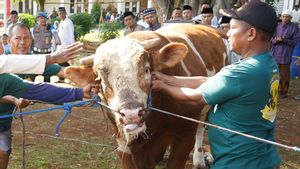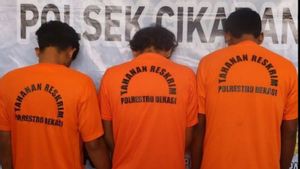BATU CITY - The Batu City area, which is one of the tourist cities in the East Java region, has just begun to crawl up after being hit by the impact of the COVID-19 pandemic.
Slowly, tourist destinations in the area are starting to be allowed to operate again in line with the stipulation of Batu City for the implementation of community activity restrictions (PPKM) level 2. The main roads in the tourist city, in recent times, especially on weekends, have started to return. crowded with vehicles that take tourists. Hotels, restaurants and tourist attractions also began to be crowded with people from various regions. In the midst of conditions that have just started to rise due to the impact of the COVID-19 pandemic, Batu City was hit by a flash flood that occurred on Thursday, November 4. The flash flood, although it did not paralyze the tourism sector, had a major impact on the region. Seven Life Victims The Batu City Regional Disaster Management Agency (BPBD) noted, until the latest report on Sunday (7/11) as many as 89 families were affected by the flash flood disaster which claimed seven lives. In addition, as many as 35 houses at six points in Batu City were reported to have been damaged, and 33 others were submerged in mud. A total of 73 motorcycles and seven cars were also damaged and hundreds of livestock died. There were six areas affected by the flash flood, namely, Sidomulyo Village, Bulukerto Village, Sumber Brantas Village, Bumiaji Village, Tulungrejo Village and Punten Village. In addition to the death toll, there were also six survivors after being swept away by the banjir bandang. Overall there were 13 people who were swept away by the flash flood. However, the incident also endangered the lives of tens or hundreds of residents who were around the location at the time of the disaster. One of the eyewitnesses who was a resident of Sambong Hamlet, Bulukerto Village, Bumiaji District, Batu City, Sri Kusumastutik (43) said the flash flood came suddenly. -Suddenly when there was heavy rain.
 Black Water Tutik, as he is known, said his two children Mutia Artahira (5) and Rehana Chalya Artanti (11) saw the black water overflow, and was filled with debris like large pieces of wood. He and his two children were in the house at the time.
Black Water Tutik, as he is known, said his two children Mutia Artahira (5) and Rehana Chalya Artanti (11) saw the black water overflow, and was filled with debris like large pieces of wood. He and his two children were in the house at the time.
In a state of panic, Tutik and his two children tried to save themselves. When leaving the house, the water and material from the banjir bandang have inundated the front of the house. Tutik's house is not far from the Sambong River. Tutik's mother, Jumini (60), was outside the house and shouted at Tutik to get out of the house and save herself. In the end, Tutik and his two children managed to leave the house safely. "We tried to run to the next house. The water was already high, and the black water was swirling. I screamed for help, and then someone in a blue shirt helped me," he said. Tutik's house is not far from the Sambong River, only a few meters away. The houses of Tutik, Sarif and Wiji's neighbors were destroyed by flash floods. Wiji is the first death victim that the disaster management team has found. Sugiyono (48), another eyewitness to the banjir bandang disaster, said that this was the first major flood he had experienced. In the previous condition, there had been floods during heavy rains, but they did not cause great damage. Sugiyono's house collapsed due to the swift flow of the flash flood that occurred at approximately 15.00 WIB. what happened to me. Thank God the three of us survived," he said.
Causes of Flash Floods Flash floods that occurred in the Batu City area, caused the flow of the Brantas River in the Malang City area to be affected. The impact caused by the banjir bandang disaster is quite large, hundreds of Malang City residents were forced to evacuate. It was recorded that 61 houses in Jatimulyo were damaged, 51 houses in Kampung Putih were damaged, 30 houses in Samaan, and two houses in Kota Lama. The City of Batu Dewanti Rumpoko conducted air monitoring in the upstream and downstream areas and obtained a number of conclusions.
Acting Head of the BNPB Disaster Data, Information and Communication Center Abdul Muhari stated that one of the causes of flash floods in Batu City and the impact on the Malang City area was the destruction of natural dams due to high water discharge. upstream is bigger. The water was held for a while. However, when the water overflows, the natural dam is destroyed and flows downward along with a number of hazardous materials. The natural dam in the upstream area of Batu City is formed from small landslides from the side of the cliff that are not protected by plants or vegetation that has strong roots. This is exacerbated by the large number of annual plantations on the slopes of river cliffs. These seasonal plantations have the potential to landslide during high-intensity rains. Seasonal plantations can easily experience landslides during high rainfall and endanger the safety of residents along the river. Seasonal plants that are on the slopes of the cliff, when it rains they will melt because the roots of vegetables, or the roots of annual plants are not binding. The Indonesian Protection of Forest and Fauna (ProFauna) Institute stated that the flash flood that occurred in the Batu City area was strongly suspected to be caused by land conversion in the protected forest. The Chairperson of ProFauna Indonesia, Rosek Nursahid, stated that in a protected forest area located on the slopes of Mount Arjuna Many have turned into vegetable farming areas. Protected forests that function to prevent landslides and maintain water availability have changed functions. "There must be rehabilitation or restoration by planting trees, not vegetables or porang plants," said Rosek. Arjuno in 2019. The fire caused many trees to fall which formed natural dams and hampered the process of water flow. The natural dam, could not withstand a large overflow of water.
 BNPB Recommendations There are a number of important recommendations submitted by BNPB in an effort to minimize the risk of banjir bandang disasters, including the need for river dams that aim to see potential blockages and natural dams. cleaning up the remnants of fallen trees so that there are no hazardous materials and can cause flash floods in the area again. Then, it is also necessary to plant hard-rooted trees on the top edge of cliff slopes, especially on the edge of annual plantation areas and in seasonal garden areas that are minimal trees with strong stands. Besides that, it also avoids the use of river valley slopes for the use of seasonal gardens, and enforcement of rules along river bodies. As well as planting vetiver on steep slopes with a slope of more than 30 degrees. Batu City Mayor Dewanti Rumpoko stated that all recommendations given by BNPB would be an important concern. The Batu City Government will immediately prepare a safe place for residents, and plant vetiver and trees with strong roots. Hopefully all land with a slope of more than 30 degrees and areas prone to landslides can be rehabilitated soon with strong rooted cover crops. In addition, a more detailed map of landslide-prone areas must be made by paying attention to waterways and the potential for puddles in hilly areas that can trigger landslides.
BNPB Recommendations There are a number of important recommendations submitted by BNPB in an effort to minimize the risk of banjir bandang disasters, including the need for river dams that aim to see potential blockages and natural dams. cleaning up the remnants of fallen trees so that there are no hazardous materials and can cause flash floods in the area again. Then, it is also necessary to plant hard-rooted trees on the top edge of cliff slopes, especially on the edge of annual plantation areas and in seasonal garden areas that are minimal trees with strong stands. Besides that, it also avoids the use of river valley slopes for the use of seasonal gardens, and enforcement of rules along river bodies. As well as planting vetiver on steep slopes with a slope of more than 30 degrees. Batu City Mayor Dewanti Rumpoko stated that all recommendations given by BNPB would be an important concern. The Batu City Government will immediately prepare a safe place for residents, and plant vetiver and trees with strong roots. Hopefully all land with a slope of more than 30 degrees and areas prone to landslides can be rehabilitated soon with strong rooted cover crops. In addition, a more detailed map of landslide-prone areas must be made by paying attention to waterways and the potential for puddles in hilly areas that can trigger landslides.
The English, Chinese, Japanese, Arabic, and French versions are automatically generated by the AI. So there may still be inaccuracies in translating, please always see Indonesian as our main language. (system supported by DigitalSiber.id)













